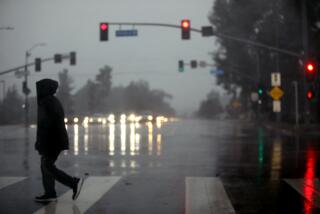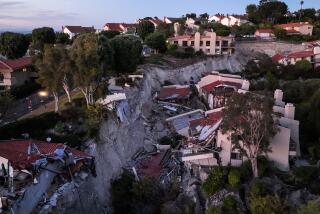Breezy Point looks back a year after Superstorm Sandy
NEW YORK — As Superstorm Sandy roared ashore a year ago, the Atlantic Ocean swelled into the streets of Breezy Point, triggering a conflagration that devoured home after home in this neighborhood perched on a sliver of land on the fringes of New York City.
Flames fueled by fierce winds climbed higher than 60 feet, danced on utility wires and turned backyard propane grills and cars’ gas tanks into bombs. In a cruel twist of nature, volunteer firefighters in this enclave of Queens scrambled to find hydrants submerged in floodwater.
“The whole place was an inferno,” said Martin Ingram, who was then chief of the Point Breeze Fire Department.
Ingram and his dozen or so firefighters stood their ground alone at first, only later to be joined by scores of New York City firefighters as Sandy battered much of the East Coast with powerful wind, torrential rain and storm surges. They halted the westward advance of the blaze after six blocks of destruction.
No one died in Breezy Point, but it suffered some of the worst devastation wrought by the historic storm. The fire, apparently caused by an electrical short, hollowed out a large chunk of this tightknit, heavily Irish American beach community, home to many first responders and retirees. The fire alone destroyed 135 homes. Flooding damaged 2,100. In all, 355 homes were destroyed.
But on Tuesday, residents and politicians here and throughout the Eastern Seaboard highlighted signs of rebuilding and recovery on the one-year anniversary of the superstorm. Ingram pointed to 22 homes rising from piles of sand and naked foundations, and construction equipment in the fire zone.
“We’re light-years ahead of where we were,” said Ingram, who had been displaced from his own home by flooding. “This is progress.”
Breezy Point’s rebirth has been halting over the last 365 days, similar to locales in Staten Island and along the Jersey Shore. The cooperative that runs Breezy Point counts 2,837 homes as members, but Arthur Lighthall, the general manager, estimates only 50% of its residents have been able to return. Residents complain of red tape holding up insurance payouts and building permits.
Mari Ellen Mack was so frustrated she decided to spend Sandy’s first anniversary in a tent she pitched in the sand pit where her bungalow’s foundation once rested.
“This is my home,” said Mack, 58. “I can do what I want.”
Her one-night campground included a cooler, beach chair and American flag. Tuesday night, she planned to uncork some champagne and invite over friends and neighbors to raise a glass. “We’re coming back,” said Mack, who has been living nearby in Brooklyn while she waits for a new modular home to arrive. “Nobody’s giving up. Nobody’s leaving.”
A year ago, the streets were an isolated disaster zone. On Tuesday, Breezy Point served as the backdrop for NBC’s nightly news broadcast and the Weather Channel. Dignitaries including Noel Kilkenny, consul general of Ireland in New York, milled about.
The Irish government donated about $300,000 to Sandy relief, some of which helped replace a flood-warped gymnasium floor at a Catholic church in Breezy Point earlier this year, Kilkenny said.
“To see this coming about right now is fantastic,” Kilkenny said amid the bang of construction workers’ hammers, as he walked near a poster declaring “Breezy strong.”
Across the peninsula, about 200 volunteers helped beef up Breezy Point’s defenses against the next storm. Using shovels, they planted American beach grass on top of a dune recently built along a stretch of beach left defenseless when Sandy arrived.
It was about 7:30 p.m. on Oct. 29, 2012, when Sandy swept ashore in New Jersey as a Category 1 hurricane that merged with other weather systems to become a rare superstorm. Before it dissipated, it had flooded low-lying areas from along the tourist-rich Jersey Shore to across the barrier islands of Long Island.
Millions were without power, subways flooded, hospitals had to be evacuated. Parts of Manhattan were cut off from food and water, and residents were stranded without elevator service in high-rise buildings, as record surges of up to 14 feet wreaked havoc. Sandy was blamed for at least 181 deaths in the East, including 68 in New York and 71 in New Jersey.
Residents marked the exact moment of Sandy’s arrival with vigils featuring candles and flashlight beams along the Jersey Shore and in Staten Island, where 23 people died in the floods that have made parts of the area around Oakwood Beach uninhabitable.
“Today, we saw firsthand examples of work being done citywide to help make New York City’s infrastructure withstand future severe weather events,” New York Mayor Michael R. Bloomberg said.
In Breezy Point, residents reflected on their struggles, as well as the lessons.
Tom Tobin, who lost a basement library and computer along with much of his other belongings when his house flooded, said Sandy reminded him that family and friends — not material things — were important in life.
“It’s given me a lot of focus,” said Tobin, 77, a retired pipe fitter, as he put his shovel to work on Breezy Point’s dune.
Others were heartened by growing signs of normalcy as friends and relatives trickled back in.
“It’s not the community it used to be until we’re all back, and that’s what we’re waiting for,” said Ingram, the former fire chief. “I’m looking forward to the day when the word ‘Sandy’ doesn’t mean anything to me.”
Times staff writer Michael Muskal contributed to this report from Los Angeles.
More to Read
Start your day right
Sign up for Essential California for news, features and recommendations from the L.A. Times and beyond in your inbox six days a week.
You may occasionally receive promotional content from the Los Angeles Times.






